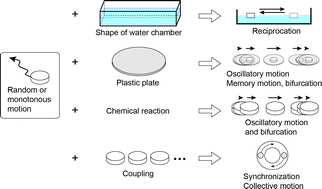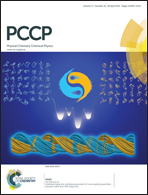Physicochemical design and analysis of self-propelled objects that are characteristically sensitive to environments
Abstract
The development of self-propelled motors that mimic biological motors is an important challenge for the transport of either themselves or some material in a small space, since biological systems exhibit high autonomy and various types of responses, such as taxis and swarming. In this perspective, we review non-living systems that behave like living matter. We especially focus on nonlinearity to enhance autonomy and the response of the system, since characteristic nonlinear phenomena, such as oscillation, synchronization, pattern formation, bifurcation, and hysteresis, are coupled to self-motion of which driving force is the difference in the interfacial tension. Mathematical modelling based on reaction-diffusion equations and equations of motion as well as physicochemical analysis from the point of view of the molecular structure are also important for the design of non-living motors that mimic living motors.


 Please wait while we load your content...
Please wait while we load your content...